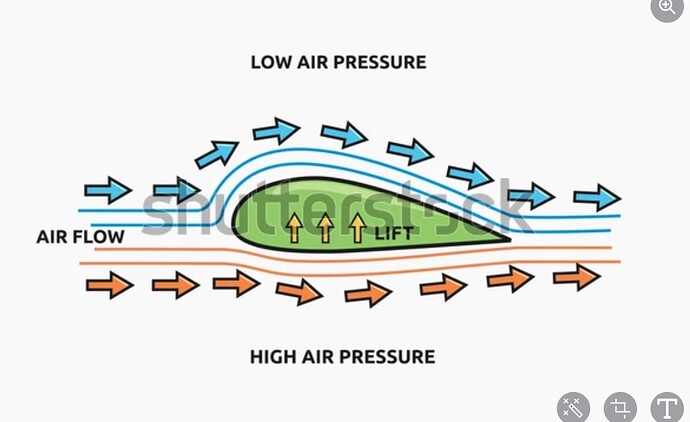Accelerating forwards relative to the air molecules the engines are interacting with, but not all the air molecules, right? (I’m not trying to be obtuse)
So accelerating forward relative to the air molecules it’s pushing on and also the treadmill, but still not the molecules that are interacting with the wings to create lift.
Me too. But it’s enough to know that, regardless of the galaxy from whence they hail, they speak my language.
The wheels on a plane are there to provide a relatively friction-less way for the plane to move across the ground. The engines provide thrust to move the plane forward.
So even if the tires were moving backwards on the treadmill, the plane would still move forward.
But the way the problem is worded the clearly magic treadmill would instantly ramp up to an arbitrarily high speed to match whatever speed the wheels were turning at, which wouldn’t work out so well for the regular, nonmagical 747 that is trying to take off. The wheels would instantly catch fire and explode and the 747 would be ground into the magic treadmill like a belt sander.
Yes, but the purpose of the plane moving forward is so more air flows under the wing than over the wing, which generates lift. If the wings are stationary relative to the air, I suspect that if the wing is not moving then the plane will not fly, even if the propeller or jet engine is working. Basically, I’m on team no flight.
edit: this image is what I’m working with mentally.
In this magic world is there also infinite friction between the wheels and ground, such that they wouldn’t skid forward when pushed by the engines? If so then it would be the wheels that essentially hold the plane in place so it couldn’t take off. If not then it skids forward and takes off.
Fyp, imo. Like, another way I’m thinking about it is that alternatively, you could have a stationary plane lift off with the engines off and the wheels not moving if you were able to blow enough air across the wings to create the sufficient amount of lift.
Basically, imo, the whole question is structured in a way to get everyone focusing on the interaction between the wheels and the ground when the only interaction, as far as flight’s concerned, is the interaction between the wings and the air around them.
Like someone said above, imagine the plane is on a frictionless pane of ice.
Is that how the wheels are designed? Engines off, no wind, brakes off, treadmill on, plane is stationary while wheels turn?
Hi.
Actual degree-holding aeronautical engineer here.
One question for all you “can’t take off” folks…
How do you think a seaplane moves forward?
Also, the thought experiment is flawed because the rules change. No friction for the wheels but air resistance for the wings? Flawed.
Assuming the conveyor can handle the friction generated at normal takeoff speeds for a small prop plane, then yes, it will be able to take off. Funnily enough, it’s because of the picture simplicitus posted… he just drew the exact wrong conclusion.
That makes zero sense to me, lol.
So how do you think a seaplane takes off?
I know less about sea planes than physics, lol, but my guess would be that the engines propel the plane forward fast enough so that there is sufficient air flowing across the wings to take off?
How do you think a seaplane moves forward?
OK what happens if you’ve got a water treadmill where whenever the air speed gets up to 1 mph the water treadmill increases speed in the opposite direction by two mph?
How do you think a seaplane moves forward?
The propeller generates thrust, which overcomes the resistance of the pontoons, moving the body of the plane forward, to a velocity where air eventually moves over the wings at a sufficient rate to generate lift, leading to takeoff.
You can put an air propeller on a regular boat and it will still move forward like a water propeller, just less efficiently. The only thing that is going to make the plane fly is motion of air around the wings, right? In the hypo I don’t see the wings moving relative to the air. If we differ I suspect it’s on this last point. I’m just assuming the wheels do nothing and are basically irrelevant, except maybe to communicate the thrust to the treadmill, which I assume speeds up a bit. [Though, in this case, with frictionless wheels I actually have to conclude the plane does move forward at the rate of thrust provided by the propeller, so eventually gets to takeoff speed. If, on the other hand, the thrust is conveyed to the wheels, then to the conveyor, speeding it up some, there is no takeoff.]
There’s no physical way for the plane to be accelerating and have the air molecules stay stationary relative to the wings unless there is a force acting on them as well.
Someone do the Monty Hall problem next.
A seaplane is floating down the Niagara river right before the falls. It’s backwards and hits the engines max thrust. The plane eventually stops floating backwards, mere feet before the precipice, it is able to reach equilibrium and stay in one spot because the water is flowing backwards so fast.
The plane then, from a relative standstill, starts floating up, for some reason I think
I definitely remember an MS paint of a seaplane on a river in the OOT debate on this topic.


